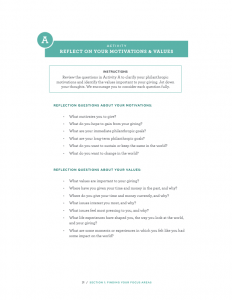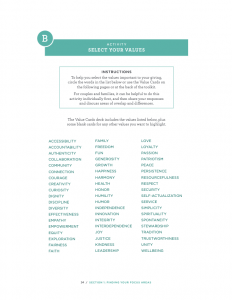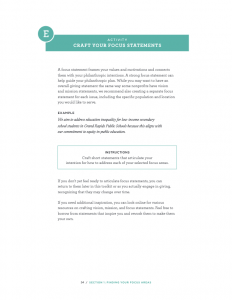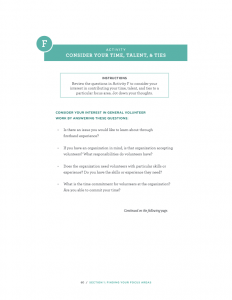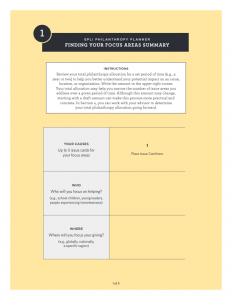Finding Your Focus
-
1.1 Clarify your motivations and values
Articulating your motivations and values allows you to develop a proactive, effective philanthropic plan rather than giving reactively to funding requests. Ultimately, your motivations and values provide the anchor for decision-making at each step of the philanthropy process.The following two activities are meant to be completed together. Activity A provides reflection questions to help clarify the motivations driving your giving as well as the values underlying it. Activity B uses Value Cards to help you identify the values that are most important to you.
ACTIVITY A. REFLECT ON YOUR MOTIVATIONS AND VALUES
Review the questions in Activity A to clarify your philanthropic motivations and identify the values important to your giving. Jot down your thoughts. We encourage you to consider each question fully.
Suggested printing instructions: Letter-size, portrait, double-sided
ACTIVITY B. SELECT YOUR VALUES
To help you select the values important to your giving, circle the words in the list below or use the Value Cards on the following pages or at the back of the toolkit.
For couples and families, it can be helpful to do this activity individually first, and then share your responses and discuss areas of overlap and differences.
Suggested printing instructions: Letter-size, portrait, double-sided
EPLI VALUE CARDS
The Value Cards deck includes the values listed below, plus some blank cards for any other values you want to highlight.
ACCESSIBILITY
ACCOUNTABILITY
AUTHENTICITY
COLLABORATION
COMMUNITY
CONNECTION
COURAGE
CREATIVITY
CURIOSITY
DIGNITY
DISCIPLINE
DIVERSITY
EFFECTIVENESS
EMPATHY
EMPOWERMENT
EQUITY
EXPLORATION
FAIRNESS
FAITH
FAMILY
FREEDOM
FUN
GENEROSITY
GROWTH
HAPPINESS
HARMONY
HEALTH
HONOR
HUMILITY
HUMOR
INDEPENDENCE
INNOVATION
INTEGRITY
INTERDEPENDENCE
JOY
JUSTICE
KINDNESS
LEADERSHIP
LOVE
LOYALTY
PASSION
PATRIOTISM
PEACE
PERSISTENCE
RESOURCEFULNESS
RESPECT
SECURITY
SELF-ACTUALIZATION
SERVICE SIMPLICITY
SPIRITUALITY
SPONTANEITY
STEWARDSHIP
TRADITION
TRUSTWORTHINESS
UNITY
WELLBEING
Suggested printing instructions: Letter-size, portrait, double-sided
-
1.2 Narrow your focus areas
The simplest way to organize your philanthropy is to focus on several specific issues, rather than giving across many issues. While your philanthropic budget certainly can allow room for reactive and emergency giving (see Section 4: Structuring Your Giving), narrowing your focus areas for proactive giving helps prioritize your resources.
This is true even if your philanthropy is concerned with a particular community—for you cannot give to every possible cause. It is also true for donors who are motivated by the philosophy of effective altruism, which is concerned with alleviating the conditions of abject poverty and avoiding global catastrophes (seeeffectivealtruism.org for more information).
We have developed two activities to help you narrow your focus areas. Both activities help you reflect on issue areas and select a few to integrate into your initial giving plan.
- LOOK BACK AT YOUR GIVING HISTORY. Activity C is for donors who have a significant history of giving. This activity will help you take stock of your past giving and determine trends and themes. From there, you can understand which issues you are most passionate about, assess how you have supported them in the past, and decide whether you would like to make adjustments.
- BEGIN WITH A CLEAN SLATE AND SELECT ISSUES WITHOUT RELYING ON PRECEDENT. If you wish to start with a clean slate, Activity D will help you explore a range of potential issues and select those that align with your values and motivations.
We also developed a deck of Issue Cards located on the following pages and in the card deck at the back of this toolkit. The full set includes the issues listed below, plus some blank cards for any other issues you want to highlight. Potential focus areas are included on the back of each Issue Card.
ANIMAL RELATED
ARTS, CULTURE & HUMANITIES
CIVIL RIGHTS & ADVOCACY
DISASTER PREPAREDNESS & RELIEF
EDUCATION
ENVIRONMENT
FOOD & NUTRITION
HEALTH
INTERNATIONAL
DEVELOPMENT
LAW & SOCIETY
SOCIAL SERVICES
OTHER
Finally, effective philanthropists often narrow their focus even further by identifying a target population and location for each issue. For example, a philanthropist who selected “education” as an issue might narrow her focus area to adolescent girls’ math education on the South Side of Chicago. Activity E guides you through narrowing your focus to target populations and locations.
The Issue Card categories were selected from the National Taxonomy of Exempt Entities, developed by the IRS and the National Center for Charitable Statistics to classify nonprofit organizations. nccs.urban.org/classification/national-taxonomy-exempt-entities

ACTIVITY C. LOOK BACK AT YOUR GIVING HISTORY
Review your previous contributions and volunteer work over a given period of time to identify issues that are meaningful to you.
Suggested printing instructions: Letter-size, portrait, double-sided
ACTIVITY D. SELECT YOUR ISSUES
The Issue Cards provide an overview of broad issue categories and include some blank cards for you to write in any other issues that might interest you—for example, a specific issue you already know you would like to fund. Read the Issue Cards and select the issues that you may be interested in supporting.
Suggested printing instructions: Letter-size, portrait, double-sided
EPLI ISSUE CARDS
Review the front side of the Issue Cards that include the topics below. These cards provide an entry point into an issue. There are also three blank cards so that you can write in any specific causes that might be meaningful to you.
Arts, Culture & Humanities Education
Health
Animal Related
Social Services
Food & Nutrition
Disaster Preparedness & Relief International Development
Environment
Law & Society
Civil Rights & Advocacy
Place-based Giving
Suggested printing instructions: Letter-size, portrait, double-sided
ACTIVITY E. CRAFT YOUR FOCUS STATEMENTS
A focus statement frames your values and motivations and connects them with your philanthropic intentions. A strong focus statement can help guide your philanthropic plan. While you may want to have an overall giving statement the same way some nonprofits have vision and mission statements, we recommend also creating a separate focus statement for each issue, including the specific population and location you would like to serve.
EXAMPLE
We aim to address education inequality for low-income secondary school students in Grand Rapids Public Schools because this aligns with our commitment to equity in public education.
If you don’t yet feel ready to articulate focus statements, you can return to them later in this toolkit or as you actually engage in giving, recognizing that they may change over time.
If you need additional inspiration, you can look online for various resources on crafting vision, mission, and focus statements. Feel free to borrow from statements that inspire you and rework them to make them your own.
Suggested printing instructions: Letter-size, portrait, double-sided
-
1.3 Contribute your time and talent
When considering levels of donor engagement, you may have heard of the “4 T’s”—Treasure, Time, Talent, and Ties. In this context, treasure is shorthand for financial contributions, time reflects the hours you are able to give, talent refers to your specific skillsets, and ties relate to your social and professional networks.
It is up to you to consider how to balance and deploy these “4 T’s” in your philanthropic endeavors at different periods in your life. There may be intervals when you don’t have much time but are happy to make significant financial donations. There may be other times when you cannot give the lead gift on a campaign but are able to consistently volunteer and make introductions to key people in your social network. Regardless of how you balance your “4 T’s,” there are many organizations that will be delighted to have you involved.
We address financial contributions in Section 4: Structuring Your Giving and Section 6: Making Gifts and Tracking Your Giving. In this section we focus on the other three T’s: Time, Talent, and Ties.
You might consider deepening your philanthropy by contributing your time and talent through volunteering. Volunteering can be an excellent way to learn more about your focus areas and get to know an organization. You can volunteer with organizations you support financially as well as other organizations. Nonprofit organizations sometimes post information about volunteer positions on their websites. Volunteer commitments can be short-term and focused around a specific event or short-term business goal, or they can be long-term and connected to a series of events, an on-going program, or extended strategic initiatives.
Another way to contribute at a leadership level is to serve on the board of a nonprofit organization. Often, an organization’s senior leadership identifies prospective board candidates based on the skills and expertise they can contribute and extends an invitation to join the board. Organizations often ask board members to be “ambassadors” for the organization, willing to tap into their social and professional networks to help the organization more effectively meet its various goals. While board service can be extremely meaningful, it can also be a significant time commitment depending on the organization’s needs and the skills and resources other board members bring to the table.
If you are considering volunteering or serving on a board, work through Activity F.
For more information on board service, refer to BoardSource in Additional Resources: Section 1 at the end of the Toolkit.
ACTIVITY F. REFLECT ON YOUR TIME AND TALENT
Review the questions in Activity F to consider your interest in contributing your time, talent, and ties to a particular focus area. Jot down your thoughts.
Suggested printing instructions: Letter-size, portrait, double-sided

